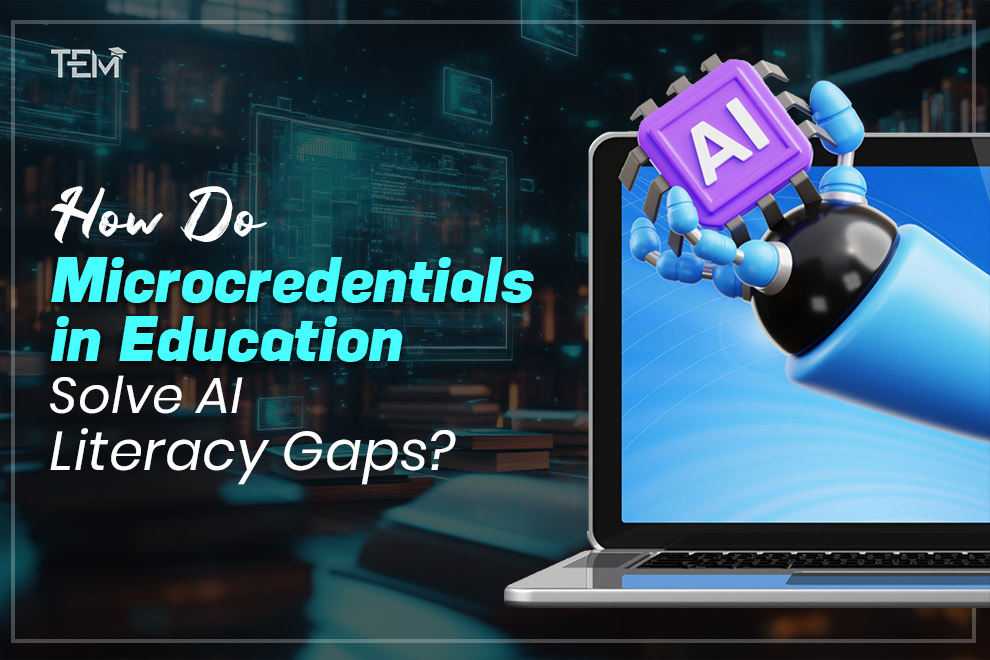Let’s be real: the AI revolution isn’t coming; it’s already here, and it’s changing everything.
It’s honestly a bit jarring, isn’t it? This shift demands we all level up our skills, but there’s a huge problem.
A massive “AI literacy gap” has opened up, and our traditional education systems just can’t keep up. It’s a critical challenge. But what if there was a better, faster way? Enter Microcredentials in education.
These are proving to be an incredibly powerful, nimble solution. They deliver the specific, verifiable skills you actually need to navigate this new AI-driven world. We’re talking about empowering people to genuinely thrive in this rapidly changing professional landscape.
Well, this guide is your deep dive into exactly how microcredentials are bridging that gap. We’ll explore how they build the crucial AI competencies we all need for a society that’s not just globally competitive, but ethically aware too.
Let’s Explore How Microcredentials in Education Solve AI Literacy Gaps
1. The AI Tsunami: Defining the “AI Literacy Gap”
So, what is this “AI literacy” everyone’s talking about?
- It’s simply the knowledge and skills you need to “get” AI—its functions, its amazing potential, and, just as importantly, its limitations.
- And listen, it’s not just for tech wizards. It’s a whole five-part competency model for everyone:
- Technical knowledge
- Practical use
- Critical thinking
- Ethical awareness
- Societal impact
- This isn’t just a random list; this complete view lines up with big-hitter frameworks from organizations like UNESCO and the World Economic Forum.
- UNESCO is pushing hard to make sure young citizens are AI-literate, so they can use it for the common good and (critically!) spot-check AI-generated content.
- The World Economic Forum is right there with them, stressing how vital it is to embed AI literacy (which is different from digital literacy) right into our education systems.
- And let’s be honest, this is urgent. The fast-paced development of AI tech has kicked up a lot of ethical dust globally because of its potential for misuse.
2. The Old Model is Broken: Why Traditional Education Can’t Keep Up
Here’s the tough truth: our traditional education models are really struggling to keep up with the breakneck speed of AI. They’re hitting some massive hurdles.
- Think about it: the sheer cost and time it takes to get a comprehensive degree is a huge barrier.
- On top of that, these traditional models often just don’t have the specificity needed. They can’t address the super-specialized AI skills that are changing by the day.
- The flexibility of our current education system is being seriously tested by… well, everything happening right now.
- And while technology can definitely help, it’s pretty surprising that there’s been fairly limited scholarly work on microcredentials in higher education so far.
3. The Solution: What Are Microcredentials (And How Do They Actually Work)?
So, what’s the fix? Say hello to microcredentials!
- What are they? They’re concise, competency-based qualifications. In plain English, they prove you have a specific skill or knowledge in one focused area.
- And the best part? You can often get them much more quickly than a traditional degree.
- They were literally designed to fix this problem. They meet the needs of an educational landscape where employers are desperate for people with specific skills that match the rapidly changing market.
- Think of them as proof of mastery in a specific skill. They’re typically smaller and, key point, stackable.
- Now, to be fair, a single, clear, globally accepted definition is still being hammered out.
- But the European Commission, for example, has a great one: they call them records of learning outcomes from a small volume of learning, which are assessed against transparent criteria. Simple and smart.
4. Digital Badges: Trust and Verifiability
How do you show you have a microcredential? Often, with a digital badge.
- These are basically electronic high-fives. They’re visual, you see them online, and they’re packed with hidden metadata.
- These verifiable microcredentials are what create those unique and flexible learning pathways we need.
- You’ve probably seen them from platforms like Credly, which is partnered up with giants like Pearson and ServiceNow. They issue digital badges that recognize your verified skills and achievements.
- That embedded metadata is the magic part. It can include all the info about the badge, proving its value in our digital world.
- It’s a totally new way to capture and tell people about your knowledge and the skills you can actually demonstrate.
- But here’s the catch: for this all to work, the microcredential must be transparent. That’s the only way to build the trust we need for everyone to adopt them.
5. The 5 Ways Microcredentials Directly Solve the AI Literacy Gap
1. Agility and Speed
This is huge. Microcredentials give you timely and agile certification of your capabilities. This is incredibly valuable in industries where specialized skills are everything. They let us respond swiftly to what the workforce needs, right now.
2. Targeted “Just-in-Time” Upskilling
This is so practical. They let you get the exact skills you need for your career goals, without having to sign up for a massive, full-degree program. It’s a modular approach. You can work through the content in a targeted, step-by-step way. They offer flexible, inexpensive content that actually matches what you need. And the good news? Opportunities to get them are popping up everywhere as more higher ed institutions build out their online offerings.
3. Accessibility & Flexibility
They open up so many doors! They give you unique, flexible learning opportunities. This means you can get personalized professional development that’s based on your individual goals and your current skills. These flexible and inclusive learning paths are exactly what the modern world is demanding—from the labor market, from employers, and from students themselves.
4. Lower Cost & Higher ROI
Let’s talk money. This is an efficient and financially smart way to deliver skills and knowledge, especially to adult learners. And get this: this approach can even have massive benefits for public four-year institutions. We’re talking an improved return on investment (ROI) on their traditional baccalaureate degrees. How cool is that?
5. Verifiable & Standardized Proof for Skills-Based Hiring
This is the trust factor again. They offer transparent and verifiable certification of your skills. The whole point is to give you digital proof that you met specific learning outcomes. And not just that—proof that you were assessed, quality-assured, and verified by a trusted body. Of course, this means standardized assessment and quality assurance are crucial. It’s how we maintain academic standards and build that trust. Ultimately, this all helps move us toward skills-based hiring because it gives companies much greater visibility into the actual skills a person has.
6. Real-World Proof: Case Studies of AI Microcredentials in Action
1. University Provider: Institute of Coding in Wales
Check this out. The Institute of Coding (IoC) in Wales ran a pilot program for digital skills bootcamps from October 2021 to July 2022. This pilot ran across Welsh universities, and the whole goal was to test if the universities could (and would) award university credits for these microcredentials. The results are fascinating!
- Out of the 16 bootcamps they ran, six of them ended with learners getting real university credits.
- The other ten still offered fantastic upskilling opportunities, just without the credit attached. A perfect example of flexibility!
2. Corporate Implementer: IBM
It’s not just universities. Big-time corporations like IBM are all in. They, along with other giants like Amazon, Microsoft, and Intel, are offering free AI courses and learning resources online. This is a massive contribution to AI literacy. It’s a clear sign of how large companies are using microcredentials to train not just their own workforce, but the public, too.
3. Individual Learner Persona: Pharmacists in New Zealand
What do the learners themselves think? A survey of practicing or intern pharmacists in New Zealand gave a crystal-clear answer.
- It showed strong support for microcredentials for their postgraduate study.
- Get ready for this number: a whopping eighty-eight percent (88%!) said they preferred a stacked microcredential program over traditional courses.
- What drove them? The top motivators were interest, skill development, and career development. It just makes sense.
7. The Other Side: Challenges and Limitations (Building Trust)
Okay, let’s not get too carried away. This rapid growth has, of course, brought some challenges. We desperately need robust frameworks and quality assurance.
- The biggest one? It’s kind of the “Wild West” out there right now regarding quality and standardization.
- There’s just no global consensus on what a microcredential even is. This lack of agreed-upon definitions can seriously undermine their value and uptake.
- People are rightfully concerned: how do we validate the comparative worth of a credential from one place versus another?
- Then there’s the “gig qualification” critique. Are these real, or just marketing hype? Are they a genuine successor to degrees, or, as some critics warn, a “wolf in sheep’s clothing” if we don’t implement them thoughtfully?
- We also have to think about learner challenges. What about folks who lack digital literacy or don’t have access to the right technology? That could create major barriers.
- Other challenging factors have been identified, too, including organizational, industrial, and technological hurdles.
- At the end of the day, maintaining public faith in the quality of these awards is absolutely crucial, especially for the higher education institutions offering them.
8. The Future is Stackable: AI Literacy as a Lifelong Journey
So, what’s next? The future is, without a doubt, stackable. This is all about AI literacy being a lifelong journey, not a one-and-done degree.
- The future of microcredentials in education is completely tied up with “stackable credentials” and “lifelong learning.”
- They let students build up their skills bit by bit, incrementally. This creates a real culture of continuous learning.
- This approach means you can earn microcredentials or digital badges, and then stack them together to build larger, more recognizable qualifications. How smart is that?
- The real appeal here is their power to respond quickly to what the workforce needs, all while fueling that lifelong learning journey to keep you employable.
- Stackable credentials are now seen as a best practice for community colleges. They help students graduate with the exact skills they need for a job.
- Plus, it supports them in pursuing full degrees while also letting them seek employment in high-growth sectors.
- Truly, the integration of AI and microcredentials… that is the future of professional development. It perfectly aligns with the non-stop need for continuous learning and upskilling for this new AI era.
My Opinion
Look, Microcredentials in education aren’t just some passing fad. You’ve got to see them for what they are: a massive, fundamental shift. We’re moving toward a dynamic, skills-based way of learning, and it’s absolutely vital for navigating the AI age.
Think about it. Their modular, verifiable design directly tackles that urgent need for real AI literacy. We’re moving past just ‘book smarts’ (theoretical knowledge) and into practical, ethical, and societal competence. It’s so impressive!
By encouraging stackable credentials and true lifelong learning, microcredentials are going to democratize access to these critical AI skills. They empower individuals and seriously strengthen our global workforce. Honestly, this adaptive approach is the only way we can build an equitable, competent, and AI-ready society—one that can grab the amazing, transformative power of AI and use it responsibly and effectively.
Here Are Some Implementation Tips
- Mix real-world proof with learning.
Don’t just test them. Design microcredentials that make learners submit actual evidence from their day-to-day practice. This shows they can really apply the skill, moving way beyond theory.
- Build it together (don’t go it alone).
You absolutely must involve everyone in the design process. Bring practicing teachers, industry partners, professional development providers, and even state education agencies to the table. This is the secret to making sure it’s relevant, fits the local context, and works with existing policy.
- Be crystal clear about the “why.”
You must clearly state the exact workforce need each microcredential fills. Make sure there’s a rock-solid, rigorous link between what’s being taught and what industry is begging for. This is how you build value and employer trust.
- Use digital badges to get specific.
Don’t just hand out a certificate. Use digital badging systems that have standardized metadata. Why? Because they allow for super-precise recognition of achievements and skills, way more granular than any traditional degree. It’s like a detailed profile of what someone can do.
- Get your own team excited!
You need a strong marketing and communication plan to get everyone on board, especially faculty and staff. You have to move beyond just the early fans. This is how you beat skepticism and make microcredentials a truly valued part of everyone’s professional growth and career path.
Did this guide help? Was it an eye-opener? If so, don’t keep it to yourself!
Please, share this ultimate guide with your colleagues, your friends, and your entire professional network. Let’s spread this vital knowledge and empower everyone to thrive in this new age of AI!











